The Bronze Age burnt mounds of Ireland are enigmatic; many theories have been proposed for their purpose, from cooking sites to prehistoric saunas. But were these monuments actually microbreweries for Bronze Age beer? In part two of our three part series, we get down to business with archaeologists who like to experiment…
Quinn and Moore decided to investigate the possibility that burnt mounds might have been brewing sites. 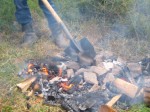 Working with the same equipment one might expect brewers to use in the Bronze Age, Quinn and Moore also benefited from a 21st century understanding of science.
Working with the same equipment one might expect brewers to use in the Bronze Age, Quinn and Moore also benefited from a 21st century understanding of science. 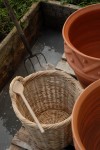 They knew that water had to be heated to approximately 67° C in order for the starch in the malted grain to be turned into soluble sugars. They knew also that modern brewers achieved this by adding milled grain to the water to make a glucose-rich, syrupy substance know as a wort, and that this mixture had to be transferred to storage vessels mixed with yeast and flavourings, and left to stand for a few days, fizzing and frothing whist the active yeast devours the sugars and excretes alcohol. Most importantly, they knew that once this process had finished, and the fizzing had finally stopped, they would hopefully have an unhopped ale.
They knew that water had to be heated to approximately 67° C in order for the starch in the malted grain to be turned into soluble sugars. They knew also that modern brewers achieved this by adding milled grain to the water to make a glucose-rich, syrupy substance know as a wort, and that this mixture had to be transferred to storage vessels mixed with yeast and flavourings, and left to stand for a few days, fizzing and frothing whist the active yeast devours the sugars and excretes alcohol. Most importantly, they knew that once this process had finished, and the fizzing had finally stopped, they would hopefully have an unhopped ale.
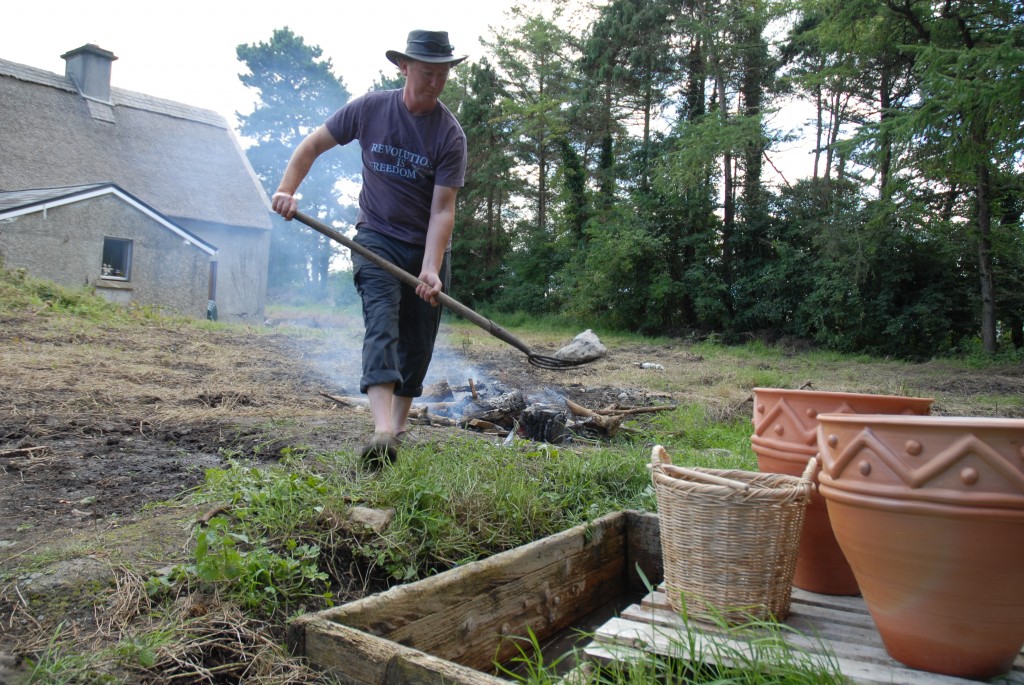 The basic ingredients of beer are milled, malted grain (barely or wheat), water, yeast and an herb flavouring (usually bitter tasting dried leaves to counter the sweetness of the brew). With all these readily to hand, the archaeologists set about preparing a trough of similar dimensions to those found at burnt mounds (known to modern brewers as a ‘mash tun’), lighting a fire to heat the stones, and some earthen-ware fermentation vessels. They began by superheating stones on a wood fire for about two hours, before transferring them to the water trough.
The basic ingredients of beer are milled, malted grain (barely or wheat), water, yeast and an herb flavouring (usually bitter tasting dried leaves to counter the sweetness of the brew). With all these readily to hand, the archaeologists set about preparing a trough of similar dimensions to those found at burnt mounds (known to modern brewers as a ‘mash tun’), lighting a fire to heat the stones, and some earthen-ware fermentation vessels. They began by superheating stones on a wood fire for about two hours, before transferring them to the water trough.
Thinking their way inside the Bronze Age mindset, they noticed that at between 60-70° C the water gently steamed, with the surface becoming glassy and mirror-still.  An interesting note to this part of the process – again, thinking with a Bronze Age mind-set – was that in future experiments, done without the aid of a modern thermometer, Quinn and Moore would know that the ideal temperature had been reached when their reflection on the surface of the water was at its clearest.
An interesting note to this part of the process – again, thinking with a Bronze Age mind-set – was that in future experiments, done without the aid of a modern thermometer, Quinn and Moore would know that the ideal temperature had been reached when their reflection on the surface of the water was at its clearest. 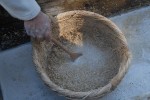 They then added their wicker basket of malted barley, stirring vigorously, and over a period of about 45 minutes the starches were converted into sugars. At this point they placed more hot stones into the trough, bringing the syrupy wort to the boil, then transferred the mixture into Bronze Age replica pottery vessels. After cooling, they added the yeast and seasonal flavourings – bog myrtle, juniper berries, and yarrow – and then settled back as the mixture began to bubble.
They then added their wicker basket of malted barley, stirring vigorously, and over a period of about 45 minutes the starches were converted into sugars. At this point they placed more hot stones into the trough, bringing the syrupy wort to the boil, then transferred the mixture into Bronze Age replica pottery vessels. After cooling, they added the yeast and seasonal flavourings – bog myrtle, juniper berries, and yarrow – and then settled back as the mixture began to bubble.
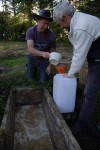 The fermentation lasted about a week, after which the beer was ready for scientific testing. Quinn and Moore invited numerous friends round to try their Bronze Age brew, which was copper-coloured, with a sharp yet sweet taste, comparable to home brew kits. The discerning palette noted the smoky caramelised flavour, imparted by the hot rocks.
The fermentation lasted about a week, after which the beer was ready for scientific testing. Quinn and Moore invited numerous friends round to try their Bronze Age brew, which was copper-coloured, with a sharp yet sweet taste, comparable to home brew kits. The discerning palette noted the smoky caramelised flavour, imparted by the hot rocks. 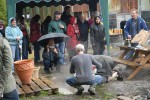 The brew could best be described as a gruit ale, an old-fashioned herb mixture used for bittering and flavouring beer, popular before the extensive use of hops. The experiment was extremely successful, transforming three hundred litres of water into 110 litres of ale with little effort; but most importantly, demonstrating that Bronze Age hot-rock technology could be used to brew beer. Thus, not only was the process of brewing beer in burnt mounds feasible, Quinn and Moore had demonstrated that it was also extremely efficient. But how well did these new insights sit with what we already know about prehistoric drinking cultures?
The brew could best be described as a gruit ale, an old-fashioned herb mixture used for bittering and flavouring beer, popular before the extensive use of hops. The experiment was extremely successful, transforming three hundred litres of water into 110 litres of ale with little effort; but most importantly, demonstrating that Bronze Age hot-rock technology could be used to brew beer. Thus, not only was the process of brewing beer in burnt mounds feasible, Quinn and Moore had demonstrated that it was also extremely efficient. But how well did these new insights sit with what we already know about prehistoric drinking cultures?
Man cannot live on beer alone
Archaeologists can only hope that when the prehistoric party was over, someone broke a few pots. Pottery made it possible to ferment, store and serve alcoholic drinks, and most importantly, its porous fabric soaked up the residues of the liquids once held inside.  Interestingly, the earliest evidence for brewing is found in the same region as the earliest evidence for pottery. Archaeo-chemist Patrick McGovern analysed samples from early Neolithic pottery found in northern China along the banks of the Yellow River, and discovered residues of an alcoholic drink made from rice, grapes and honey dating to 9,000 years ago.
Interestingly, the earliest evidence for brewing is found in the same region as the earliest evidence for pottery. Archaeo-chemist Patrick McGovern analysed samples from early Neolithic pottery found in northern China along the banks of the Yellow River, and discovered residues of an alcoholic drink made from rice, grapes and honey dating to 9,000 years ago.
In the ‘fertile crescent’ of the Middle East, Neolithic farmers were developing a monoculture based on barley. Alcoholic residues have been discovered from pottery vessels associated with possible brewing pits in this region. Beer is more nutritious than bread, containing more vitamins and essential amino acids; some have even questioned whether beer, rather than bread, was the driving force of civilization. Residues show, however, that mixed fermented honey mead was the most likely drink of choice. As Neolithic culture expanded westwards, coming into contact with native traditions and experience, brewers began to specialize with different ingredients and techniques, and beer as we know it was invented.
Burnt mounds date from the Neolithic, but the high watermark for their use was the later Bronze Age, sometime after western Europe came under the influence of the Beaker culture.  This period is defined by the common use of a specific pottery style dating to the 3rd millennium BC. ‘Beakers’ have a distinctive bell shaped profile, and analysis of Scottish examples from tombs at Ashgrove in Fife and North Mains in Strathallan suggest that the vessels contained a fermented drink – possibly a sweetened ale or mead. The spread of Beaker technology across western Europe was in close association with the increasing growing of barley, which may also have been stimulated by the Bronze Age taste for alcohol. If Quinn and Moore’s Great Beer Experiment demonstrated that burnt mounds could feasibly be used for the production of beer, the wider Bronze Age context showed that there was an appetite, and a demand.
This period is defined by the common use of a specific pottery style dating to the 3rd millennium BC. ‘Beakers’ have a distinctive bell shaped profile, and analysis of Scottish examples from tombs at Ashgrove in Fife and North Mains in Strathallan suggest that the vessels contained a fermented drink – possibly a sweetened ale or mead. The spread of Beaker technology across western Europe was in close association with the increasing growing of barley, which may also have been stimulated by the Bronze Age taste for alcohol. If Quinn and Moore’s Great Beer Experiment demonstrated that burnt mounds could feasibly be used for the production of beer, the wider Bronze Age context showed that there was an appetite, and a demand.
The only problem now was finding the archaeological evidence….
Did they find any evidence, or was this experimental theory destined to wake up with a nasty hangover?
Check out the latest Current Archaeology on news stands now, or tune in next Friday for the third and final installment in our mellow boozy drama.
Epilogue – A brief history of time gentlemen please
Last year’s celebrated Guinness advert – set to Sammy Davis Jr. singing ‘The Rhythm of Life’ – was a play on the brewery’s marketing strategy: the best things come to those who wait. It featured three men in a pub taking a satisfying sip of Guinness, before stepping backwards in time, devolving through each evolutionary stage to become three bug-eyed amphibians – distant ancestors of our three drinkers – sipping from a fetid pool.
The advertisers would have us believe that our pint was well worth the wait, but how long exactly have we been waiting? What can archaeology tell us about the invention of alcohol?
The first clear evidence for alcohol dates back 9,000 years, and has been recovered in China by archaeologists using chromatography-mass spectrometry to find tell-tale signatures for rice wine on fragments of Neolithic pottery.
Astronomers probing our galaxy have found that alcohol does not just exist on Earth. A gigantic cloud of ethanol (Sagittarius B2N) has been detected near the centre of the Milky Way some 26,000 light years away. It should come as no surprise, then, that sugar fermentation (glycolsis) was the earliest form of energy production used by life on Earth. Four billion years ago, single-celled microbes dined on simple sugars, excreting a mix of ethanol and carbon dioxide: from the very beginning, carbonated alcoholic drinks were available on Earth.
 It took slightly longer for complex organisms to make their way to the bar, but once they had discovered the pungent, enticing aroma of fermenting sugars turned to alcohol by wild strains of yeast, there was no turning back. The ‘drunken monkey’ hypothesis was proposed by the biologist Robert Dudley whilst observing Malaysian tree shrews’ penchant for binging on fermented palm nectar. Early hominids would have been primarily fruit eaters, and it is entirely possible that we evolved both a taste for alcohol, and livers capable of detoxifying after overindulgence.
It took slightly longer for complex organisms to make their way to the bar, but once they had discovered the pungent, enticing aroma of fermenting sugars turned to alcohol by wild strains of yeast, there was no turning back. The ‘drunken monkey’ hypothesis was proposed by the biologist Robert Dudley whilst observing Malaysian tree shrews’ penchant for binging on fermented palm nectar. Early hominids would have been primarily fruit eaters, and it is entirely possible that we evolved both a taste for alcohol, and livers capable of detoxifying after overindulgence.
Without direct physical evidence, it is difficult to date the first intelligent production of alcohol beyond the first pottery vessels of the Neolithic, but an enigmatic carving of a woman holding a ‘drinking horn’ dating back 22,000 years led Patrick McGovern to develop ‘The Palaeolithic Hypothesis.’  Gathering ripe grapes in leather or wooden containers, hunter-gatherers would have noticed the natural fermentation of the juices left in the bottom. Recognising that this process could be speeded up by manually crushing the grapes, and that the taste of aromatic liquid improved once left to settle, it is no great leap to see our early ancestors developing a thirst for the good stuff.
Gathering ripe grapes in leather or wooden containers, hunter-gatherers would have noticed the natural fermentation of the juices left in the bottom. Recognising that this process could be speeded up by manually crushing the grapes, and that the taste of aromatic liquid improved once left to settle, it is no great leap to see our early ancestors developing a thirst for the good stuff.


Good work, Fascinating and would explain a lot about why we still do it, why it is widespread amongst many cultures etc.
The next significant bit is then about those people, Inuit, Native Americans, Aboriginals and some ‘chinese cultures’ Didn’t develop the liver enzymes to detoxify alcohol.?